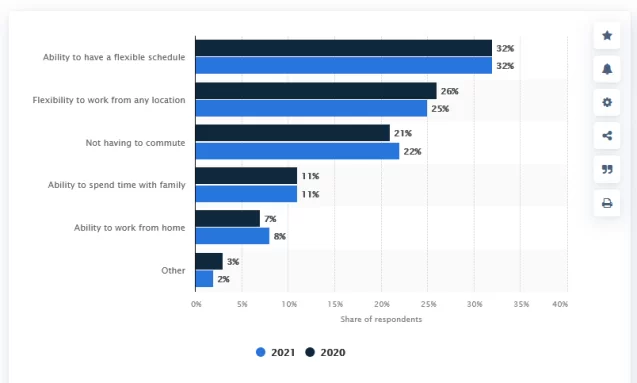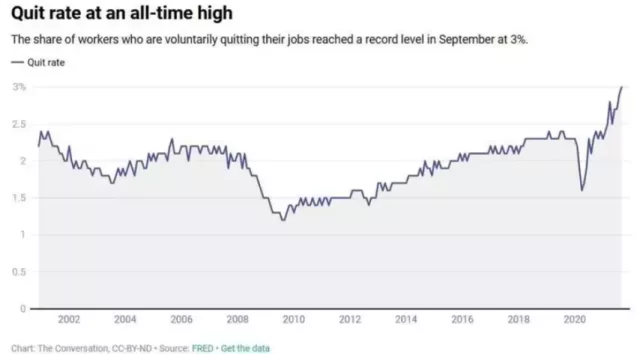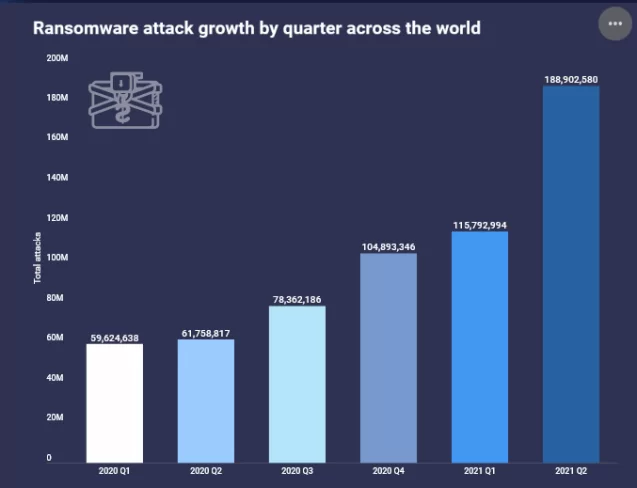It has been nearly two years since the COVID pandemic has disrupted the traditional work paradigm, pushing over 17% of the global workforce — and that is a whopping 557 million employees — to work from home. And although this massive shift was a necessity, there was no roadmap for businesses to follow and it was a learning curve for all of us.
Now, as we are gradually moving past the experimental stage, it’s becoming clear that remote work is not going anywhere. A survey conducted by FlexJobs revealed that 65% of workers wanted to continue working remotely full-time after the pandemic and 58% said they would even look for a new job if they weren’t allowed to work from home in their current position.
These numbers should not come as a surprise since the benefits of remote work are indeed numerous. The graphics below is based on the data from Statista and describes the main benefits people experience when working remotely.
Source: Statista
What’s even more impressive is the productivity boost that comes with all that flexibility, fewer interruptions, and less water cooler talk. According to different sources, from 15% to 55% of employees report an increase in their productivity.
To capitalize on that, many companies are increasingly leaning into the new model and allowing their employees to work remotely full or part-time. The most well-known examples include:
- Twitter was among the first big tech companies to offer its staff to work from home as long as they want;
- Apple offers the option to work remotely twice a week as well as a 2-week work-from-anywhere benefit;
- Microsoft allows employees to work remotely part-time (less than 50%) and full-time with a manager’s approval;
- Shopify announced a move to become a digital-by-default company, allowing its employees to permanently work from home;
- Slack too implemented a permanent remote work policy, encouraging even top execs to work from home at least two days per week.
Remote work has clearly moved from a nice perk to an expected benefit. But what does it mean in the long run? Will companies stay remote-first after the pandemic? And what are the legal implications of this massive shift? Well, let’s see where we are all headed.
Work landscape trends in 2022 and beyond
The rise of a hybrid workforce
As the office-centric culture is giving way to more flexible ways of working, the effective post-pandemic workplace is yet to be shaped since what works for one business may not be as efficient for another. The full-time work-from-anywhere model may not be the right fit for everyone as workers, especially new hires, need a stronger bond and shared workplace experiences.
Many companies, including such giants as Google, Facebook, Salesforce, and Amazon offer hybrid work environments — a combination of working remotely and in traditional office settings. The hybrid work model allows employees to reap the benefits of working from home and maintain the connection with co-workers that simply cannot be achieved in a Zoom meeting. In fact, 63% of high-growth businesses successfully use the hybrid model.
Better collaboration tools
With the onset of the pandemic, businesses were forced to quickly adopt new virtual communication and collaboration tools to support their remote staff. Those first months of virtual meetings and conferences were often plagued by technical issues — we all remember a lawyer from Texas who accidentally got stuck with a cat filter on a Zoom meeting.
Now, to support a permanent hybrid workforce, businesses need to step up their tech game and prioritize improved collaboration. According to a survey by Forrester Consulting, only 37% of respondents are satisfied with their existing collaboration and productivity solutions.
The collaboration and productivity software market is starting to catch up and is expected to reach $26 billion by 2027. From multi-party video calls and video conferences to secure files exchange and real-time content collaboration, modern solutions are designed to support remote workforce and globally dispersed teams. To take team collaboration to the next level, forward-thinking companies invest in AI-powered tools like virtual assistants and smart analytics tools that help organize low-value tasks like scheduling a meeting or derive better business insights for informed decision-making.
The Great Resignation
A year ago, professor Anthony Klotz of Texas A&M University predicted the Great Resignation — a phenomenon that describes large numbers of people leaving their jobs when life returns to normal after the COVID pandemic. Just in September, a record 4.4 million workers quit their jobs in the US alone. The highest resignation rates are observed in the technology and healthcare industries.
Source: Weforum
The massive exodus of workers is felt throughout Europe, too. For instance, in the UK job vacancies rose to a record high in July, with available single-month vacancies exceeding 1,000,000 for the first time. In Germany, almost 35% of companies are reporting a shortage of skilled workforce.
As the Great Resignation is accelerating, businesses need to rethink their talent strategies and prepare a roadmap for retaining the workforce. For starters, In addition to flexible work environments, employers need to invest in upskilling and retraining, as well as continuous development opportunities for their workforce. Staff augmentation and outsourcing are also viable options as they help companies access a wider pool of talent and close the expertise gap.
Bigger role of cybersecurity
IT security is one of the biggest problems that companies face when moving towards a hybrid workplace. When employees start using their personal devices and private or public networks that lack robust security controls, the attack surface expands dramatically. This makes remote workers an easy prey to all sorts of attacks, including malware, phishing, or ransomware.
A report from Atlas VPN says that ransomware attacks were up 151% in the first half of 2021, compared to 2020. Within the same period, cybercriminals launched almost 5.4 million DDoS attacks, which is also an uptick from the previous year. And FortiGuard Labs warns that 2022 is shaping up to be yet another banner year for cybercriminals.
Source: Atlas VPN
To protect from breaches and attacks attributed to hybrid work, organizations are expected to boost investments in cyber-risk management and deploy stringent security services like granular authentication and authorization, zero-trust network access, BYOD policies, enhanced security analytics, and more.
The employment law is catching up
The paramount shift in a work paradigm that we witness today also needs to be reflected in revised labor rights that would equally protect in-office and remote employees without discrimination against the latter. Today, this is not always the case — for example, office-based employees are often perceived as more hard-working and therefore are promoted more frequently.
And although legal reforms take time, we already see certain changes on the horizon:
- In Portugal, the parliament approved the new labor laws that prohibit employers to contact employees outside of business hours;
- In France, employers with at least 50 workers must negotiate agreements to allow workers to disconnect from work technology after hours.
- In Italy, the right to disconnect was established in law back in 2017;
- In Spain, employees are guaranteed the right to digitally disconnect during off-work hours to ensure respect for their rest time, holidays and privacy;
- In the UK, the government considers making flexible working the default.
Wrapping up
To say that the workplace landscape is changing rapidly would be an understatement. The pandemic has jammed a decade of digital transformation into a single year, pushing millions of people to work from home.
And while it is yet not clear what this shift will mean in the long run, there is no denying that a hybrid model will be prevalent in the future. For employers, that means integrating better collaboration and communication tools and focusing on improving the employee experience to help workers handle the digital overload and retain talent. No less important are legal changes and new labor laws as they will form the foundation for a successful hybrid workforce.












